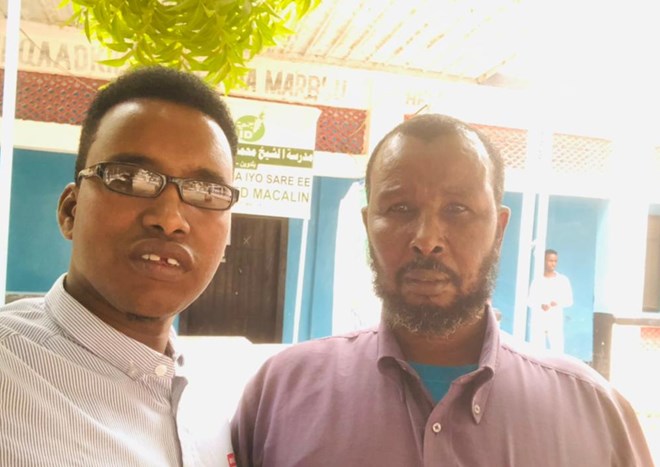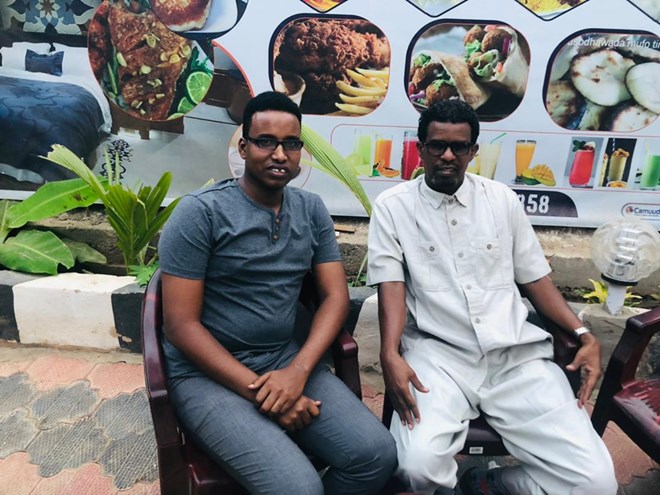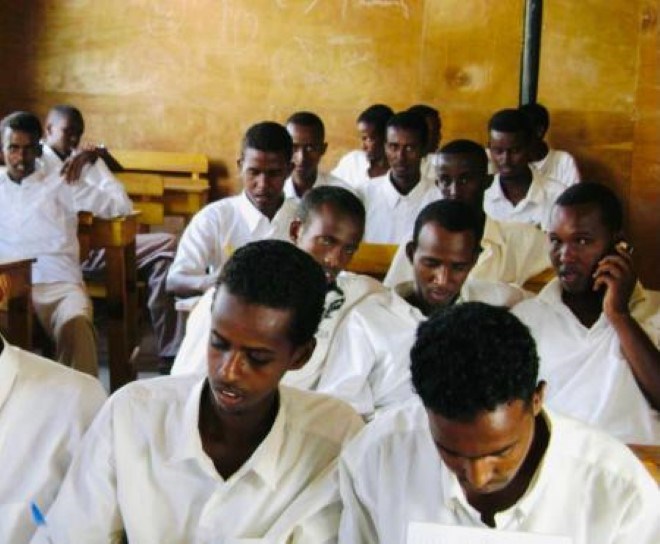Wednesday, October 6, 2021
By Mahad Wasuge

After almost three years away (two years and nine months, to be exact), I traveled back to Beledweyne for a short assignment. The last time I was there was in December 2018. That previous trip was my first return to the town after eight years away. At that time, I wrote a blog post titled ‘Back to Beledweyne eight years later.’ I was excited to go back to the town again. I spent three good years in Beledweyne between 2006 and 2009 studying at a secondary school. These three years shaped my life in many ways. I also learned many tough lessons from the fragile security situation, recurrent floods, and armed clashes.
When I visited Beledweyne in December 2018, I was disappointed with what I saw. I felt that the situation had not improved after almost a decade since I left the town.
This time, the situation was different. Upon arrival, I have seen an ongoing construction of a new terminal at Ugaas Khaliif airport. A bus was also there picking up passengers to the city. Similar to the bus I saw in Baidoa, the Beledweyne bus collects $3 from each passenger. Only a few other vehicles have access to the airport, so passengers have no other option.
Beledweyne has a tarmac road constructed recently. The tarmac road starts in between the airport and the city. The driver who picked me up from the airport began explaining why the tarmac road started from there. He said that the initial plan was to construct 6 kilometers from Janta Kundishe to the Howlwadaag bus station near the bridge (locally known as Buundo Liiqliiqato) that links the Howlwadaag village in the west to the other parts of the town. However, after deliberations and suggestions from Hirshabelle’s former president, three kilometers were switched to Howlwadaag village.
After arriving at the hotel I was booked to stay at, the driver pointed his fingers at a man sitting with three others in a far corner of the hotel restaurant. He said, “do you know that man?” I said I wasn’t sure. “He is General Xuud,” the driver said. In less than one hour, I was sitting with General Xuud. He only had two bodyguards (not armed with guns). I knew he was a military general. I told him about my father, and he immediately remembered him as they were both working for the military forces and raised/extended his hand again and greeted me. For about 20 minutes, we were chatting, and I asked him several questions about the militias he mobilized and his vision for the Hiiraan region and the Hawadle clan he hails from. He was confident in his response and emphasized how his movement got overwhelming support from the community. He emphasized that he wanted Hiiraan as a region to establish its own state. However, I did not get a clear picture of how such aspiration can be realized, and the means he thinks can make this a reality.
I had the opportunity to meet with the Hawadle Ugaas, – Ugaas Yusuf Ugaas Hassan Ugaas Khaliif. He is the son of the late Ugaas Hassan Ugaas Khaliif, who died in Mogadishu in February 2021. He is a young man in his late 30s. He is calm, humble, and a good listener. We both grew up in Buulaburte, but we were in different peer groups. He recognized my face, but he could not tell who I was. After a short explanation, he recognized my family and me. He spoke about my elder brothers and sisters he knows and expressed his condolences for my brother, who died recently. Ugaas Yusuf is a young man, but he is already playing a key role in reconciling warring clans. We talked about politics, the upcoming elections, and reconciliations.
It was a great pleasure to visit my high school, Sheikh Mohamed Moalin Primary and Secondary School. The school principal, Ahmed Dhaqane, invited me to speak to students at the podium the day I reached the town. But when I arrived at the school, I found out that the classes started earlier than I thought, and students were already studying. The vice-principal, Ustaad Tawane Maquul, my former Tarbiya and Mathematics teacher, asked me to talk to students from last year (12th grade). Grade 12 has three classes (A, B, & C). class A is only for male students; class B is a mix of male and female, while class C is only for females. Twelve years ago (2009), when I graduated from the school, we had only nine female students who graduated with us. Now, the school has 90 female students graduating this year!
Teachers told me that students are not at the same level as we were and are not showing the same effort and dedication that we had. Smartphones and social media are consuming a lot of students’ time. I spoke to the three Grade 12 classes. I described to them my life and study in Beledweyne and the situation of Sheikh Mohamed Moalin School in a difficult period. I emphasized the opportunities they have, which we did not have when we were in their class. I told them how we were in an exam when the Ethiopian troops invaded Somalia and how fighting between the Islamic Courts Union and those forces started in the outskirts of Beledweyne in December 2006. While in an exam, parents came to the school who wanted to take their kids from the school. The exam was halted, and we ran away without knowing if we would come back to the school again.

I recounted that I was coming to the school to take lessons while Ethiopian forces were standing at the front gate (they used to cut the telecommunication antenna, bring soldiers to the main streets, and collect water from the town in the morning). I emphasized that they (students) have peace and have no excuse for not studying hard. I also reminded them that their time is the most precious thing in their life. I hope my words inspired some of them and would have a positive impact on their future.
I have a special connection with Sheikh Mohamed Moalin School, and I could not express the feeling I had while I was at the school. It is also great to see some of my teachers and administrators who are still working there, fighting ignorance and bringing light to the lives of the young generation. My classmate, Hussien Santur (also known as Diyeeshe), is now a teacher at the school. When he saw me at the school, he hugged me and invited me to the Grade 11 class he was in, and I spent few happy minutes with him and the students in that class. It was also a special privilege to meet and chat with two of my teachers – Osman Ato (my Arabic Language teacher) and Mohamed Ali Dirie (my Geography and History teacher). I am glad that my relationship with my teachers has continued over the years.
Meeting with my high school classmates resuscitated some fond and fun memories. While sitting with a friend, two of my former classmates – Mohamed Farah Osoble & Abdisalan Abdullahi Osman – came to us in an evening. I immediately started narrating the story of a clash between Mohamed Farah Osoble and a young teacher invigilating us on our last day of the secondary examination. My seatmate and good friend Abdi Hassan Afrah (Bacadoow) and I had lunch together. After finishing secondary school, Bacadoow relocated to Beergidiid, a township near Beledweyne, where his parents live. He lives a happy life there with his family and is also a school teacher. Visiting Anab Ahmed (another classmate) and her family was fun and brought back memories. She kept photos of us at the school on the last day of our study (June 05, 2009). These were memorable photos. As we were swiping through the pictures, I said to Anab and Osoble that evening that the sad part for me was that I was not in the photos because I was the photographer! Seeing the photos reminded us of great memories, classmates (and how our body shapes have changed!)

Dr. Mohamed Hussein (best known as Dr. Mohamed Somali) is a childhood friend from Buulaburte. We went to the same Madarasa and primary school. We used to compete for Qur’an recitation. We went to Mogadishu University the same year, and I used to visit him at the weekends during our university study years. He has invested a lot of his time studying health and working with experienced doctors in Mogadishu. When he relocated to the Maxaas district in the Hiiraan region, he became one of the best doctors in Hiiraan. While in Maxaas, he even successfully executed an operation that hospitals in Mogadishu had failed to do. After staying a short while in his hospital in Beledweyne, we went to a restaurant and had a long conversation. I was amazed by his work and success. He has opened two hospitals in Hiiraan (one in Beledweyne and another in Maxaas) and employed over 40 health professionals. I commended his work and contribution to the people in the Hiiraan region.
Another young man thriving in Beledweyne is Mohamed Osman Makaraan. Several years ago, he founded Hiiraanweyn Radio, a widely listened station. It is the source of news and information for about 80% of the people in Beledweyne. The radio has branches in Buulaburte, Jalalaqsi, and Jowhar. I was able to pay a courtesy visit to the journalists at the Radio station in Beledweyne.
Liban Abdullahi Mumin is a friend who started and graduated at the same time as me from the same faculty at Mogadishu University. He is also doing well. After graduation, he studied law, worked with a notary public in Mogadishu, and then opened his own service in Beledweyne. His office is organizing and documenting the increasing land and property transactions in Beledweyne and other districts in Hiiraan.
What inspired me most was that none of these young people who are doing great things in Beledweyne was willing to relocate to Mogadishu. This is often the case for many young people living in other towns in Somalia. They were happy and wanted to stay in Beledweyne. This is important and valuable for the Hiiraan region.
Aside from the great things that the youth are doing in Beledweyne, business is also booming. In less than three years, several hotels were constructed. Some others were under construction. About three years ago, I struggled to get a hotel with a restaurant inside. This time I was staying in a friendly, clean hotel. The hotel has a restaurant and a good space for afternoon tea. It is adjacent to the Shabelle River. It also has a hall that is used for weddings. The business community is prospering in Beledweyne.
On the other hand, the Hirshabelle and Beledweyne administrations are locked in the Lamagalaay neighborhood, with offices and residences. They have little connection with the rest of the town and maintain their security. It reminded me of the Halane wall that divides Mogadishu’s residents and the international actors (diplomats, international NGOs, and companies).
I left Beledweyne happy and hopeful. The people I met and what I have seen in the city inspired me in many ways. The city has a bright future. Beledweyne has shaped my life, and I was pleased to reconnect with relatives, teachers, and friends. I feel great hope for the town in the years ahead.
Mahad Wasuge is the Executive Director of Somali Public Agenda, a non-profit public policy and administration research organization based in Mogadishu.